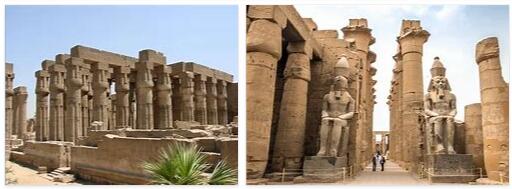Main Attractions in Luxor, Egypt
Luxor is a city of monuments. Luxor is a very ancient city, founded on the ruins of the former capital of Egypt dating back to one and a half thousand years BC, and it is rightfully considered one of the most visited places by lovers of antiquity.
Due to the fact that many ancient temples, mosques and tombs have been preserved on the territory of the beautiful city, Luxor is called the city of the dead and the living. Its territory is divided by the majestic Nile into two halves, on which modern residential areas and thousand-year-old historical monuments adjoin.
VALLEY OF QUEENS
One and a half kilometers from the Valley of the Kings is the burial place of the wives and children of the rulers of ancient Thebes of the XIX and XX dynasties. It is in this place that the notorious Queen Nefertiti is buried. The tomb is located underground, in a limestone grotto. The discovered grave was restored for a long time, since the salt contained in the underground waters significantly spoiled the drawings on the walls.
In addition to the grave of the queen, there are more than 70 graves in the grotto. Each grave consists of a narrow corridor, side chambers for things and a burial compartment. The walls of the chambers are decorated with colorful paintings depicting gods, goddesses and religious scenes. When visiting the underground grotto, you need special clothing: shoes on the blocks and face masks.
MUSEUM OF ANCIENT EGYPTIAN ART
This museum contains many works of art by ancient masters from the pre-dynastic period to the Islamic era. The collection of antiquities is located in a modern building with 2 floors. In addition to sculptures depicting pharaohs and queens made of stone, limestone and wood, the collection can be admired with jewelry, furniture, papyri and other items for burial or rituals. Also in the museum there are ancient sarcophagi with mummies buried in them.
On the second floor of the museum building there is a whole reconstructed sandstone wall, transported from the temple of Amenhotep IV. Nearby are the statues that were found in the Luxor Temple underground. The statues are so perfectly preserved that it seems that they were only recently created by the skillful hands of a stone carver. In one of the halls there is an ancient chariot belonging to Tutankhamun. You can also see the hunting and ritual weapons of that time.
MUSEUM OF MUMMIFICATION
To learn more about how the ancient Egyptians prepared for the burial of dead people, it is worth visiting the Mummification Museum. In this place, you can learn in detail about all the processes that were observed by the ancient Egyptians when mummifying people or animals.
In the museum you can see mummies, examine the tools and find out the compositions for embalming and processing during mummification. In the large halls there are departments in which coffins and sarcophagi are located for storing mummies.
The central exhibit of the museum is the well-preserved mummy of Masahart, who was the son of King Panediam. They found his burial in Dyor el-Bahri, from where the coffin with the body was delivered after a thorough study.
In addition to human bodies, in the museum you can see a rich collection of various mummified animals, perfectly preserved to this day. Fish, reptiles, pets of the pharaohs, a monkey – each exhibit is several thousand years old.
VALLEY OF THE KINGS OR THE GREAT MAGICAL NECROPOLIS
The mysterious burial place of many rulers of ancient Thebes is surrounded by secrets and legends. The Valley of the Kings is a huge necropolis, which is located in limestone deposits near modern Luxor. The bowl-shaped valley is surrounded on all sides by sheer cliffs. To get into the valley, you need to go through a rather narrow winding passage between high limestone deposits. In ancient times, the passage to the tombs was guarded by guards. Also, guard houses were located along the entire perimeter of the valley.
The first excavations of graves began 200 years ago. The western part of the necropolis is still closed to the public; excavations are underway on the recently discovered graves of Amenhotep III and other pharaohs. You can visit in the western direction only the tomb of the successor of Tutankhamun – the ruler of Au. The main excursions take place in the Eastern part of the necropolis.
It is worth knowing that photographing the tombs inside is prohibited, the guards have the right to seize the cameras without return.
SCULPTURES OF THE COLOSSES OF MEMNON
The Colossi of Memnon are two large sculptures that have been in the same place for more than 3000 years – in the necropolis of Thebes, across the Nile River from modern Luxor.
Two sculptures, located 22 meters apart, depict Pharaoh Amenhotep III. The ruler sits on a throne, his face is turned to the sunrise. On each throne are carved figures of the mother and wife of the pharaoh. The statues are made of heavy blocks of sandstone, transported from the territory where modern Cairo is located. The weight of one statue exceeds 680 tons, the height is more than 18 meters. There is an opinion that one statue, which has significant damage, collapsed as a result of an earthquake.
Mysterious legends are connected with these statues, telling that the statues sang at sunrise when the sun’s rays hit them. After the restoration of one of the statues after damage in 130, the singing stopped.



